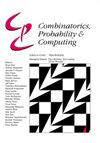无次图的可选择性
IF 0.8
4区 数学
Q3 COMPUTER SCIENCE, THEORY & METHODS
引用次数: 0
摘要
给定一个图$H$,我们分别用$f_\chi (H)$和$f_\ell (H)$表示$H$ -次要无图的最大色数和最大列表色数。哈德维格1943年著名的着色猜想指出$f_\chi (K_t)=t-1$每$t \ge 2$。一个密切相关的问题,在过去受到了极大的关注$f_\ell (K_t)$,它是众所周知的$2t-o(t) \le f_\ell (K_t) \le O(t (\!\log \log t)^6)$。因此,$f_\ell (K_t)$与$f_\chi (K_t)$的推测值$t-1$之间至少有一个常数因子的界限。Seymour提出了所谓的$H$ -Hadwiger猜想,要求证明$f_\chi (H)={\textrm{v}}(H)-1$对于一个给定的图$H$(这将由Hadwiger猜想隐含)。在本文中,我们证明了$f_\ell (H)$上的几个新的下界,从而探索了$H$ -Hadwiger猜想的一个列表着色扩展的极限。我们的主要结果是:对于每个$\varepsilon \gt 0$和所有足够大的图$H$,我们有$f_\ell (H)\ge (1-\varepsilon )({\textrm{v}}(H)+\kappa (H))$,其中$\kappa (H)$表示$H$的顶点连通性。对于每一个$\varepsilon \gt 0$,存在$C=C(\varepsilon )\gt 0$,使得几乎每一个边为$\left \lceil C n\log n\right \rceil$的$n$顶点图$H$都渐近地满足$f_\ell (H)\ge (2-\varepsilon )n$。第一个结果推广了最近关于完全二部图和完全二部图的结果,并表明对于所有具有线性连通性的大图$H$, $H$ -次要图的列表色数与$({\textrm{v}}(H)-1)$的期望值被一个常数因子分开。第二个结果告诉我们,对于几乎所有具有超对数平均度的图形$H$, $f_\ell (H)$与$({\textrm{v}}(H)-1)$之间的间隔是一个任意接近$2$的常数因子。从概念上讲,这些结果表明$f_\ell (H)$接近于$f_\chi (H)$的推测值$({\textrm{v}}(H)-1)$的图$H$通常是相当稀疏的。本文章由计算机程序翻译,如有差异,请以英文原文为准。
On the choosability of -minor-free graphs
Abstract Given a graph $H$ , let us denote by $f_\chi (H)$ and $f_\ell (H)$ , respectively, the maximum chromatic number and the maximum list chromatic number of $H$ -minor-free graphs. Hadwiger’s famous colouring conjecture from 1943 states that $f_\chi (K_t)=t-1$ for every $t \ge 2$ . A closely related problem that has received significant attention in the past concerns $f_\ell (K_t)$ , for which it is known that $2t-o(t) \le f_\ell (K_t) \le O(t (\!\log \log t)^6)$ . Thus, $f_\ell (K_t)$ is bounded away from the conjectured value $t-1$ for $f_\chi (K_t)$ by at least a constant factor. The so-called $H$ -Hadwiger’s conjecture, proposed by Seymour, asks to prove that $f_\chi (H)={\textrm{v}}(H)-1$ for a given graph $H$ (which would be implied by Hadwiger’s conjecture). In this paper, we prove several new lower bounds on $f_\ell (H)$ , thus exploring the limits of a list colouring extension of $H$ -Hadwiger’s conjecture. Our main results are: For every $\varepsilon \gt 0$ and all sufficiently large graphs $H$ we have $f_\ell (H)\ge (1-\varepsilon )({\textrm{v}}(H)+\kappa (H))$ , where $\kappa (H)$ denotes the vertex-connectivity of $H$ . For every $\varepsilon \gt 0$ there exists $C=C(\varepsilon )\gt 0$ such that asymptotically almost every $n$ -vertex graph $H$ with $\left \lceil C n\log n\right \rceil$ edges satisfies $f_\ell (H)\ge (2-\varepsilon )n$ . The first result generalizes recent results on complete and complete bipartite graphs and shows that the list chromatic number of $H$ -minor-free graphs is separated from the desired value of $({\textrm{v}}(H)-1)$ by a constant factor for all large graphs $H$ of linear connectivity. The second result tells us that for almost all graphs $H$ with superlogarithmic average degree $f_\ell (H)$ is separated from $({\textrm{v}}(H)-1)$ by a constant factor arbitrarily close to $2$ . Conceptually these results indicate that the graphs $H$ for which $f_\ell (H)$ is close to the conjectured value $({\textrm{v}}(H)-1)$ for $f_\chi (H)$ are typically rather sparse.
求助全文
通过发布文献求助,成功后即可免费获取论文全文。
去求助
来源期刊

Combinatorics, Probability & Computing
数学-计算机:理论方法
CiteScore
2.40
自引率
11.10%
发文量
33
审稿时长
6-12 weeks
期刊介绍:
Published bimonthly, Combinatorics, Probability & Computing is devoted to the three areas of combinatorics, probability theory and theoretical computer science. Topics covered include classical and algebraic graph theory, extremal set theory, matroid theory, probabilistic methods and random combinatorial structures; combinatorial probability and limit theorems for random combinatorial structures; the theory of algorithms (including complexity theory), randomised algorithms, probabilistic analysis of algorithms, computational learning theory and optimisation.
 求助内容:
求助内容: 应助结果提醒方式:
应助结果提醒方式:


